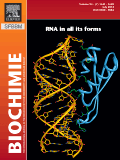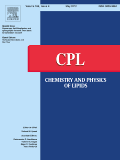
BIOCHIMIE
Scope & Guideline
Driving Excellence in Biochemical Research and Communication
Introduction
Aims and Scopes
- Translocator Protein (TSPO) Research:
The journal has a strong emphasis on TSPO, exploring its structure, function, and therapeutic potential in various diseases, including neurodegenerative disorders and cancer. - Lipid Metabolism and Signaling:
A consistent focus on lipid biochemistry, including the role of lipids in cell signaling, metabolism, and disease pathology, reflects the journal's commitment to understanding lipid-related biological processes. - Mitochondrial Function and Bioenergetics:
Research articles frequently address mitochondrial dynamics, bioenergetics, and their implications in health and disease, showcasing the importance of mitochondria in cellular metabolism. - Protein Dynamics and Interactions:
The journal includes studies on protein interactions, structural biology, and enzyme kinetics, contributing to the understanding of protein functionality in biochemical pathways. - Microbial Biochemistry and Pathogenesis:
A significant portion of the research focuses on microbial biochemistry, including the characterization of microbial enzymes and their roles in pathogenesis, which is crucial for developing therapeutic strategies.
Trending and Emerging
- TSPO and Neurodegenerative Disease:
Research on the translocator protein (TSPO) has surged, particularly regarding its role in neurodegenerative diseases such as Alzheimer's, reflecting a growing interest in targeted therapies and diagnostics. - Lipidomics and Disease Correlation:
There is an emerging trend in lipidomics, with studies linking lipid profiles to various diseases, emphasizing the significance of lipid metabolism in health and disease. - Mitochondrial Dysfunction in Disease:
Increased focus on mitochondrial dysfunction as a key factor in various diseases, including metabolic and neurodegenerative disorders, highlights the importance of mitochondrial health in therapeutic strategies. - Microbial Enzymes in Therapeutics:
Research on microbial enzymes and their applications in therapeutics is gaining momentum, particularly in the context of antibiotic resistance and novel drug development. - CRISPR and Gene Editing Technologies:
The rise of CRISPR and other gene editing technologies is reflected in recent studies, indicating a shift towards genetic and epigenetic approaches for therapeutic interventions.
Declining or Waning
- Plant Biochemistry:
Research related to plant biochemistry, particularly in the context of stress responses and metabolic pathways, has diminished, possibly due to a shift towards more applied research in agricultural biotechnology. - Basic Enzyme Mechanisms:
There has been a noticeable reduction in publications focusing solely on basic enzyme mechanisms without direct application to disease or therapeutic contexts, indicating a trend towards translational research. - Traditional Antimicrobial Studies:
The exploration of traditional antimicrobial mechanisms in isolation has waned, likely due to the emergence of more complex studies examining multi-target approaches and resistance mechanisms. - Non-coding RNA Studies:
Research on non-coding RNAs, although still present, has decreased relative to the explosive growth observed in the early 2020s, as the field matures and researchers focus on more specific applications. - General Metabolic Pathway Studies:
Studies that broadly cover metabolic pathways without a specific focus on disease relevance or therapeutic implications are declining, as emphasis shifts to targeted metabolic interventions.
Similar Journals

Biomolecules
Where groundbreaking research meets open access knowledge.Biomolecules is a prestigious, peer-reviewed journal published by MDPI that has been dedicated to advancing the field of biochemical research since its launch in 2011. With an impressive impact factor positioning it in Q1 for Biochemistry and Q2 for Molecular Biology as of 2023, this journal serves as a vital platform for disseminating high-quality research findings related to biological macromolecules, including proteins, nucleic acids, and carbohydrates. Operating as an Open Access journal, it ensures that vital research is accessible to all, furthering knowledge dissemination and collaboration within the scientific community. Located in Basel, Switzerland, the journal has established a significant presence in major academic databases, holding commendable Scopus rankings in both Biochemistry and Molecular Biology. Researchers, professionals, and students will find Biomolecules an invaluable resource for cutting-edge research, reviews, and insights in the rapidly evolving domains of biochemistry and molecular biology.

Cell Reports
Advancing the Frontiers of Molecular DiscoveryCell Reports is a prestigious open-access journal published by CELL PRESS that has firmly established itself as a leading voice in the fields of Biochemistry, Genetics, and Molecular Biology. Since its inception in 2012, the journal has provided an innovative platform for rapid dissemination of cutting-edge research, ensuring that high-quality findings are accessible to a global audience. With an impressive impact factor and ranking within the top 10% in its category, as reflected by its Q1 ranking in Scopus, Cell Reports serves a vital role in advancing scientific knowledge and fostering collaboration among researchers. The journal's commitment to the open-access model not only enhances visibility but also encourages the sharing of critical advancements in molecular biology. Situated in the Netherlands, its contributions are recognized worldwide, making Cell Reports an indispensable resource for scientists aiming to stay at the forefront of their fields and facilitate breakthroughs that may shape the future of biomedicine.

JOURNAL OF CELLULAR BIOCHEMISTRY
Pioneering Innovative Discoveries in Cellular BiologyJournal of Cellular Biochemistry is a premier academic journal dedicated to advancing the field of biochemistry and cellular biology. Published by Wiley, this influential journal has a significant impact factor that underscores its relevance and authority within the scientific community. With its ISSN 0730-2312 and E-ISSN 1097-4644, the journal has been on the frontier of research since its inception in 1982, and is expected to continue publishing cutting-edge studies through 2024. As evidenced by its ranking in the 2023 Scopus Quartiles, it holds a rank of Q2 in Biochemistry and Q3 in both Cell and Molecular Biology, placing it among the top tiers of scientific journals in these disciplines. The Journal of Cellular Biochemistry serves as a vital resource for researchers, professionals, and students alike, providing a platform for the dissemination of innovative ideas and findings that shape our understanding of cellular processes and biochemical pathways. Though it does not currently offer Open Access options, its robust peer-review process ensures that each publication meets the highest academic standards, thus solidifying its esteemed position in the landscape of biochemical research.

Biochemistry and Cell Biology
Shaping the future of biochemistry and cell biology through shared insights.Biochemistry and Cell Biology, published by Canadian Science Publishing, is a prestigious journal that has been instrumental in advancing the fields of biochemistry, molecular biology, and cell biology since its inception in 1986. With an impressive scope spanning innovative research findings to comprehensive reviews, this journal serves as a vital resource for researchers, professionals, and students alike. Currently positioned in the Q2 quartile in Biochemistry and Q3 quartiles in both Cell Biology and Molecular Biology, it reflects a robust contribution to scientific discourse, placing it among reputable publications in its field. The journal boasts notable rankings within the Scopus database, highlighting its impact and relevance, and continues to be a valuable platform for disseminating pivotal research. By providing access to a wide array of articles, the journal remains committed to fostering knowledge and collaboration in the scientific community.

CELLULAR & MOLECULAR BIOLOGY LETTERS
Advancing the Frontiers of Cellular and Molecular ScienceCELLULAR & MOLECULAR BIOLOGY LETTERS, published by BMC, is a premier open-access journal dedicated to disseminating high-quality research in the fields of Biochemistry, Cell Biology, and Molecular Biology. Established in 1996, the journal has emerged as a leader in its domain, boasting an impressive Q1 ranking across three critical categories as of 2023, reflecting its significant impact within the scientific community. With an ISSN of 1425-8153 and an E-ISSN of 1689-1392, it offers accessible research findings to a global audience, having been open access since 2013. Situated in the United Kingdom, at CAMPUS, 4 CRINAN ST, LONDON N1 9XW, the journal continues to serve as a vital resource for researchers, professionals, and students, contributing to advancements in the understanding of cellular and molecular processes. By providing a platform for original research, reviews, and short communications, CELLULAR & MOLECULAR BIOLOGY LETTERS plays a crucial role in fostering dialogue and collaboration within the scientific community.

CHEMISTRY AND PHYSICS OF LIPIDS
Advancing lipid science for a healthier tomorrow.Chemistry and Physics of Lipids is a prestigious and influential journal dedicated to advancing the understanding of lipid chemistry and biophysics. Published by Elsevier Ireland Ltd, it serves as a vital resource for researchers and professionals in the fields of biochemistry, cell biology, and molecular biology. The journal has a strong standing within the academic community, as reflected in its 2023 Scopus rankings, where it places in the 82nd percentile for organic chemistry and maintains significant positions in various biochemistry subfields. Spanning from 1966 to 2024, it fosters a comprehensive discourse on lipid-related research and innovation. As a renowned publication in the Q2 and Q3 quartiles across several categories, it supports the dissemination of high-quality research aimed at elucidating lipid functions and their implications in health and disease. Researchers and students alike will find this journal invaluable for staying updated with the latest developments and trends in lipid research.

Nature Metabolism
Illuminating the pathways of metabolism and biology.Nature Metabolism, published by NATURE PORTFOLIO, is a leading journal dedicated to advancing the field of metabolic research and its implications across various biological systems. Since its inception in 2019, this esteemed journal has rapidly established itself as a vital resource for researchers, professionals, and students alike, reflecting its prominence through a prestigious Q1 ranking in several key categories including Cell Biology, Endocrinology, Diabetes and Metabolism, Internal Medicine, and Physiology. With an impressive Scopus ranking, underscoring its impact in Medicine and Biochemistry disciplines, Nature Metabolism offers an exceptional platform for disseminating high-quality research that explores the intricate mechanisms of metabolism and its association with health and disease. Although currently not open access, it continues to gain visibility and appreciation within the scientific community, ensuring that groundbreaking findings reach interested audiences globally from its hub in Berlin, Germany. Whether you are an experienced researcher or an aspiring student, Nature Metabolism serves as an invaluable asset in navigating the complexities of metabolic science.

FEBS LETTERS
Where Innovation Meets Biological DiscoveryFEBS LETTERS, published by Wiley, is a prestigious journal that has firmly established its place in the fields of biochemistry, biophysics, genetics, molecular biology, cell biology, and structural biology. With an esteemed history dating back to 1968, this journal continues to be a vital resource for researchers and professionals involved in the biological sciences. It boasts impressive quartile rankings, including Q1 statuses in several categories such as Biochemistry and Genetics, reflecting its high impact factor and significant contribution to scientific discourse. FEBS LETTERS provides a platform for innovative findings and critical reviews, fostering the exchange of knowledge and ideas within the scientific community. Although it operates under a subscription model, the journal ensures broad dissemination of groundbreaking research through its rigorous peer-review process. The vibrant discussions encouraged by articles published in FEBS LETTERS aim to inspire current and future generations of scientists to push the boundaries of biological understanding, making it an indispensable resource for anyone dedicated to advancing their knowledge in these dynamic fields.

BIOCHIMICA ET BIOPHYSICA ACTA-BIOENERGETICS
Illuminating the Pathways of Energy TransformationBIOCHIMICA ET BIOPHYSICA ACTA-BIOENERGETICS is a prestigious journal published by Elsevier, dedicated to advancing the fields of biochemistry, biophysics, and cell biology. Established in 1967, this journal is committed to disseminating high-quality research that unveils the molecular mechanisms of bioenergetics, encompassing a wide range of topics from mitochondrial function to energy metabolism. With an exceptional impact factor and a current ranking in the Q1 quartile across multiple categories—specifically ranked #13 in Biophysics and featuring strong positions in Biochemistry and Cell Biology—this journal is recognized for its influential contributions to the scientific community. Scholars, researchers, and students globally benefit from its rigorous peer-review process and access options, although it is not currently open access. By providing a platform for innovative research, BIOCHIMICA ET BIOPHYSICA ACTA-BIOENERGETICS plays a critical role in fostering scientific advancement and collaboration among professionals in the field.

BIOCHEMISTRY
Pioneering discoveries that shape the future of biochemistry.BIOCHEMISTRY is a premier academic journal published by the American Chemical Society, dedicated to advancing the field of biochemistry through the dissemination of high-quality research. With an ISSN of 0006-2960 and an e-ISSN of 1520-4995, this esteemed publication has been a vital resource since its inception in 1962 and continues to contribute to the scientific community, boasting a remarkable Q1 ranking in the field as of 2023. The journal's well-curated content emphasizes fundamental biochemical research, molecular genetics, and innovations in biochemical techniques, catering to a diverse audience of researchers, professionals, and students. Although not an open-access publication, BIOCHEMISTRY plays a crucial role in facilitating knowledge exchange and fostering academic collaboration globally, making significant contributions to the understanding of the biochemical processes that underpin life.